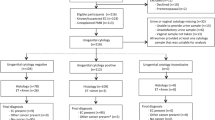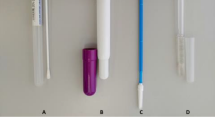Abstract
Visual inspection of the uterine cervix by paramedical personnel has been proposed for the early detection of cervical cancer, as an alternative to routine cytology screening in developing countries. We evaluated the performance of this procedure in detecting precursor lesions and cancer in a study involving 2843 married women in Kerala, India. Two thresholds were used to define a positive test. In the lower one, any abnormality was considered as positive. The cut-off point for the high threshold was one or more of the high-risk findings: bleeding on touch, suspicious growth/ulcer and hard, irregular, oedematous cervix. A Pap smear was performed on all subjects, and a biopsy was done for those with moderate dysplasia and above. A combination of cytology and histology findings was used as the 'gold standard'. Using the low threshold, 1279 (45%) women were positive on visual inspection, and with the higher threshold 179 (6.3%) were positive. There were six moderate dysplasias, nine severe dysplasias, ten carcinomas in situ and 13 invasive carcinomas. With the lower threshold, sensitivity and specificity to detect moderate dysplasia and above were 65.8% and 55.3% respectively; the values for severe dysplasia and above were 71.9% and 55.3% respectively and for invasive cancer were 92.3% and 55.2% respectively. With the higher threshold, the sensitivity decreased considerably (28.9% to detect moderate dysplasia lesions, 31.3% for severe dysplasia and 53.8% for clinical cancer) and the specificity increased to approximately 94%. At a lower threshold, the sensitivity was not satisfactory, and the test was highly non-specific; at a higher threshold sensitivity was even lower. Thus, the test characteristics of visual inspection are not very promising either as a preselection procedure for cytology or as a low-technology measure for cervical cancer screening in developing countries.
This is a preview of subscription content, access via your institution
Access options
Subscribe to this journal
Receive 24 print issues and online access
$259.00 per year
only $10.79 per issue
Buy this article
- Purchase on Springer Link
- Instant access to full article PDF
Prices may be subject to local taxes which are calculated during checkout
Similar content being viewed by others

Author information
Authors and Affiliations
Rights and permissions
About this article
Cite this article
Wesley, R., Sankaranarayanan, R., Mathew, B. et al. Evaluation of visual inspection as a screening test for cervical cancer. Br J Cancer 75, 436–440 (1997). https://doi.org/10.1038/bjc.1997.72
Issue Date:
DOI: https://doi.org/10.1038/bjc.1997.72
This article is cited by
-
Machine Learning for Automated Quality Evaluation in Pharmaceutical Manufacturing of Emulsions
Journal of Pharmaceutical Innovation (2020)
-
Evaluating the implementation of cervical cancer screening programs in low-resource settings globally: a systematized review
Cancer Causes & Control (2020)
-
Influences on uptake of reproductive health services in Nsangi community of Uganda and their implications for cervical cancer screening
Reproductive Health (2007)
-
Application of cytology and molecular biology in diagnosing premalignant or malignant oral lesions
Molecular Cancer (2006)


